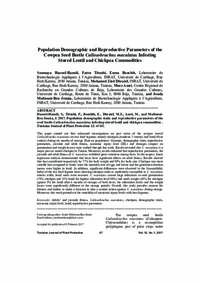Population Demographic and Reproductive Parameters of the Cowpea Seed Beetle Callosobruchus maculatus Infesting Stored Lentil and Chickpea Commodities

Authors:
This paper carried out first exhausted investigations on pest status of the cowpea weevil
Callosobruchus maculatus on two food legumes namely chickpea (Amdoun 1 variety) and lentil (Ncir
variety) during six months of storage. Data on populations’ dynamic, demographic traits, reproductive
parameters, juvenile and adult fitness, economic injury level (EIL) and damages (impact on
germination and weight losses) were studied through this work. Results revealed that C. maculatus is a
major pest on stored chickpea in Tunisia. Moreover, results indicated that reproductive parameters, the
juvenile and adult fitness of C. maculatus exhibited great variations among hosts. In this respect, linear
regression analysis demonstrated that hosts have significant effects on adult fitness. Results showed
that host contributed respectively by 77% for body weight and 80% for body size. Chickpea was more
suitable host compared to lentil, since the mortality rate of eggs and larvae and the generation duration
means were higher in lentil. In addition, significant differences were observed in the Susceptibility
Index of the two food legume hosts showing chickpea seeds as moderately susceptible to C. maculatus
attacks while, lentil seeds were resistant. C. maculatus caused large reductions in seed germination
(78% chickpea and 33% lentil for highest infestation level 80%) and seeds weight (45% for chickpea
against 8% for lentil after 6 months of storage) of both hosts; the infestation levels and the weight
losses were significantly different in the storage periods. Overall, this study provides reasons for
farmers and traders to make a decision to take a control action against C. maculatus during storage.
Moreover, this work pointed out the variability of economic injury levels with host legumes.
